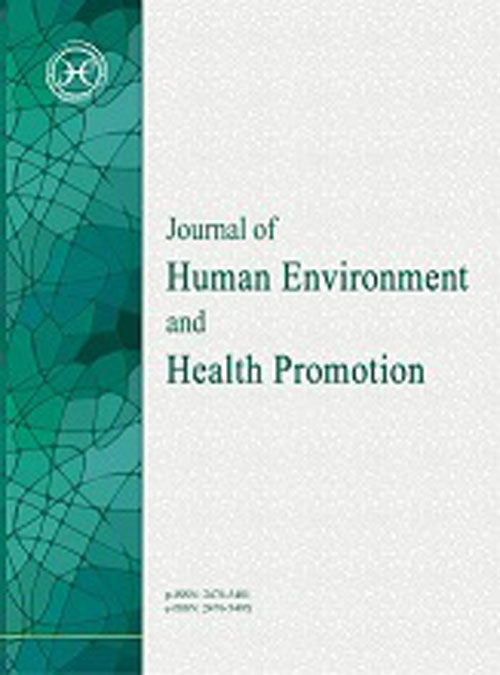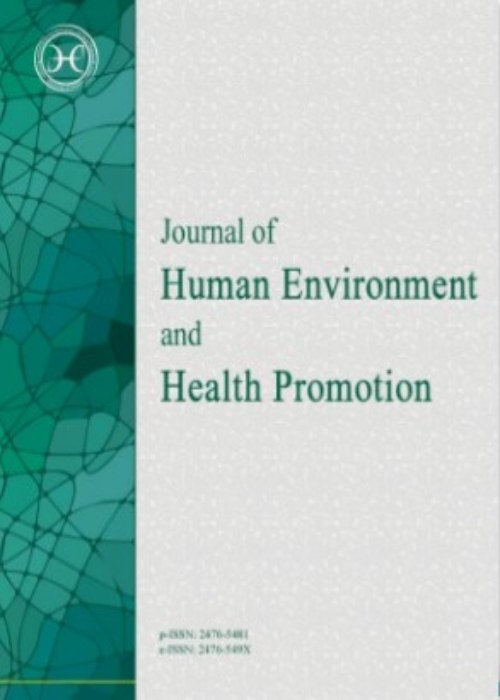فهرست مطالب

Journal of Human Environment and Health Promotion
Volume:8 Issue: 1, Winter 2022
- تاریخ انتشار: 1401/03/11
- تعداد عناوین: 8
-
-
Pages 1-9Background
Contamination of vegetables remains important for transmitting intestinal parasites in developing countries. This study aimed to investigate the types and levels of parasitic contamination of six commonly consumed vegetables in Jos, Nigeria.
MethodsLeafy vegetables (cabbage, African spinach, spring onion, lettuce, fluted pumpkin leaf, and sorrel leaf) were purchased from five central markets in Jos, from September 2020 to February 2021. Samples were rinsed in sterile water, 0.9% saline, 1.5% saline, and vinegar (containing 1.7% acetic acid) and then processed using sedimentation concentration technique. Sediments were examined using direct wet preparation.
ResultsOverall prevalence of parasitic contamination was 75.9% (n = 270). African spinach recorded the highest contamination (91.1%), followed by lettuce (86.7%), while spring onion had the least contamination. Sixteen helminths and 4 protozoans were identified. Taenia species had the highest prevalence (33.9%), followed by Entamoeba histolytica (28.5%). Schistosoma haematobium had the least prevalence. Parasitic contamination was significantly different among markets and vegetable types (P<0.05). Preliminary findings revealed that 1.5% saline rinse generally resulted in the highest parasite detection rates.
ConclusionFindings revealed a high burden of parasitic contamination of leafy vegetables in Jos, Nigeria. Public enlightenment on proper handling and processing of vegetables, from farm to table, is recommended.
Keywords: Parasitic intestinal diseases, Vegetables, Nigeria -
Pages 10-14Background
This study evaluated the bacterial contamination and the antibiogram of bacterial isolates in Intensive Care Units in Federal Medical Centre, Umuahia.
MethodsSterile swab sticks moistened with sterile water were used to swab the surfaces of the fomites, hands and anterior nares of healthcare workers and the samples were sent to the laboratory for analysis. Plasmid preparations was done with a QIAprep Spin Plasmid Kit. Antibiotic discs of prior resistance were aseptically introduced into the Muller Hinton agar plates, ensuring that the discs made appropriate contact with the surface of the agar. These were incubated for 24 hrs at 37ºC after which plates were examined for cured colonies.
ResultsThe common bacterial isolates were Staphylococcus aureus, 39(43.2%), Escherichia coli, 16(17.9%), Pseudomonas spp, 10(11.2%), Coagulase-negative Staphylococci, 7(7.8%). Antibiotic sensitivity of the bacterial isolates was carried out using the disc diffusion method. Gram-negative bacterial isolates were more sensitive to Ofloxacin, Peflacine, Ciprofloxacin, and Streptomycin. Gram-positive bacterial isolates were more sensitive to Ciprofloxacin, Gentamicin, Rifampicin, Erythromycin, and Levofloxacin. However, Enterobacter spp. and Coagulase-negative Staphylococci were resistant to the drugs. The biofilm formation potential was observed in 41(46.0%) bacterial isolates. Extended Spectrum Lactamase (ESBL) producers among E. coli isolates was 56.2%, while Klebsiella pneumoniae and Pseudomonas spp. isolates were 33.3% and 40%, respectively, Plasmid profile was carried out on some of the bacterial isolates. Six E. coli isolates had plasmid size between 50-400 base pair; five S. aureus isolates had plasmid size between 35-150 base pair, two Proteus spp. and two Pseudomonas spp. isolates had no plasmid.
ConclusionThis study revealed the resistance of bacterial isolates after currying.
Keywords: Bacterial isolates, Plasmid profile, Antibiogram, Intensive care unit -
Pages 15-21Background
Today, one of the environmental problems in the world is pharmaceutical waste, which has the potential to be hazardous, toxic, and pathogenic with a long half-life and cumulative properties. This study aimed to develop and validate a tool to measure knowledge, attitude, and behavior of household pharmaceutical waste disposal in urban households.
MethodsThe initial items of the questionnaire were developed based on existing guidelines, standards,literature, andexperts' opinions. Content validity ratio (CVR) and content validity index (CVI) were used to confirm the content validity of the tool. Item impact score was used to determine face validity. The internal consistency of the instrument was evaluated using Cronbach's alpha. Test-retest analysis was used for examining over time consistency. All the data were analyzed using SPSS version 21.
ResultsBased on the results of CVI, CVR, and impact scores, 36 items remained. The tool's internal consistency and over time consistency were confirmed with Cronbach's alpha coefficient of 0.82 and correlation coefficient of 0.9, respectively.
ConclusionThe results indicated proper psychometric properties of the questionnaire and confirmed that it is valid for measuring urban households' knowledge, attitude, and behavior about the disposal of pharmaceutical waste.
Keywords: Attitude, Behavior, Knowledge, Pharmaceutical waste -
Pages 22-26Background
Lately, consumption of natural preservatives to improve food products' shelf life has been the center of attention. Due to the approved health benefits of the oak fruit, its application in food industry as a preservative seems satisfying.
MethodsAntimicrobial activity of the alcoholic extract of the oak fruit in concentrations of 200, 400, 600 and 800 mg/mL was investigated on Escherichia coli, Staphylococcus aureus, Salmonella typhi, Klebsiella pneumoniae, and Saccharomyces cerevisiae with well diffusion technique. In order to detect the minimum inhibitory concentration (MIC) and minimum bacterial concentration (MBC), macro-dilution broth and subculturing on solid culture media techniques were used.
ResultsThe most growth prevention and inhibitory effect was observed in S. aureus, S. cerevisiae, K. pneumoniae, S. typhi, and E. coli, respectively. The most and the least antimicrobial activity of the oak fruit extract were observed in S. aureus (MIC=0.15 mg/mL and MBC = 0.313 mg/mL) and E. coli (MIC = 2.5 mg/mL and MBC=5 mg/mL), respectively.
ConclusionThe alcoholic extract of Iranian oak fruit had antimicrobial activity, and its impact was more profound on gram-positive bacteria such as S. aureus and S. cerevisiae than gram- negative ones namely E. coli, K. pneumoniae, and S. typhi.
Keywords: Alcoholic extract, Antimicrobial activity, Quercus brantii -
Pages 27-34Background
Lead and cadmium can enter the human body through consuming the liver of animals such as sheep, which may accumulate and cause adverse effects. The levels of lead and cadmium in the liver samples of slaughtered sheep in Zanjan and Sanandaj were investigated in the summer of 2014.
Methods96 Samples were collected from both cities. Lead and cadmium levels were measured by anodic stripping voltammetry (ASV) after digestion with nitric acid and hydrogen peroxide in 3 steps by a 400-watt microwave digester. Lead and cadmium concentrations were determined in µg/L using standard solutions of lead and cadmium as standard addition in their specific potential, -0.42 and -0.58 V for lead and cadmium, respectively.
ResultsMean values of cadmium in the livers of sheep in Zanjan and Sanandaj were 0.42 ± 0.13 and 0.35 ± 0.13 mg/kg, respectively, which had no significant difference (P <0.05). On the other hand, mean concentrations of lead in the livers of sheep in Zanjan and Sanandaj were equal to 3.69 ± 1.43 and 2.36 ± 0.18 mg/kg, respectively, which had a significant difference (P<0.05).
ConclusionThe concentrations of lead and cadmium in the livers of sheep were higher than WHO standards. However, only the lead levels were higher than the maximum residue levels (MRLs) standard lists. The obtained results can be due to the activities of lead industries and factories in both cities, which may increase pollution levels in the water, air, and animal feed.
Keywords: Cadmium, Lead, Liver, Polarographl, Sheep -
Pages 35-41Background
This study aimed at developing and using a semi-quantitative method for analyzing safety resilience in the chemical industry. This cross-sectional, descriptive-analytical study was carried out in 2018-2020.
MethodsThis cross-sectional, descriptive-analytical study aimed to develop a semi-quantitative method for analyzing resilience based on the Delphi method including 18 experts in chemical and process engineering as well as the health, safety and environment (HSE) engineering.
ResultsThe development of the semi-quantitative method for analyzing safety resilience took place after three rounds of the Delphi study. In this Delphi study, all the members of the experts' panel approved the three components of preparedness, likelihood, and severity with an 80% acceptance level. The results of the field study revealed 131 hazardous elements. The maximum and minimum values of resilience were found to be 500 and 100 belonging to failure in utility and failure in the distributed control system, respectively.
ConclusionThe developed semi-quantitative method has acceptable reliability for the analysis of safety resilience in the chemical industry. Therefore, the analysis in the chemical industry can be considered an effective, necessary decision-making instrument for predicting and preventing dangers threatening the process, manpower, and nature of the chemical industry.
Keywords: Resilience, Safety, Chemical industry, Delphi method -
Pages 42-48Background
Pharmaceutical wastewater mainly contains high levels of organic matter. In order to produce a suitable wastewater for discharge into the municipal sewage, chemical and electrochemical methods have been studied. The aim of this study was to evaluate the efficiency of chemical coagulation/electro-Fenton combination process in chemical oxygen demand (COD) reduction of pharmaceutical wastewater.
MethodsThe effect of Poly aluminum chloride (PAC) concentration 25-300 mg/L and pH of 3-7-10 were investigated. The effluent of chemical coagulation stage was transferred to the electro-Fenton stage. Fur
thur, the effect of H2O2 concentration 100 - 4000 mg/L, contact time of 15-120 min, voltage of 10-30 v and pH of 3-10 were investigated.ResultsThe results showed that the highest removal rate of COD was 93.5% in the optimal conditions at coagulant dose 200 mg/L and pH of 7 for the coagulation process, and at concentration of 100 mg/L hydrogen peroxide, the voltage of 20, pH of 3 and contact time of 30 min for the electro-Fenton process (EFP). The results showed that chemical and electrochemical processes are effective methods for the pharmaceutical wastewater treatment.
ConclusionIt is generally concluded that combined processes are more effective than the coagulation process alone in removing organic compounds from pharmaceutical wastewater.
Keywords: Chemical coagulation, Electro-Fenton, COD, Pharmaceutical industry wastewater -
Pages 49-61Background
Today, increasing the world’s population and efforts of countries to achieve economic growth, this research, aims to study the variables affecting economic and environmental efficiency.
MethodsIn the first part of the envelopment analysis of network data the economic efficiency of European Union (EU) countries was calculated according to the input variables. In the second part, the environmental efficiency of EU countries was evaluated based on the two important outputs of greenhouse gas emissions and the absorption of polluting gases. Finally, countries were ranked accordingly.
ResultsCorrelation analysis showed that almost all input and output variables are positively correlated and thus meet the isotonic need. Likewise, all of them can be selected for evaluation using the DEA technique. Also the results indicated that 5 countries, including Denmark, France, Germany, the Netherlands, and the United Kingdom were efficient in the first stage. Besides, Cyprus, the Czech Republic, Ireland, Latvia, and Luxembourg were in the second step.
ConclusionThe results of this study showed that none of the countries was recognized as total efficiency. Thus, none of the countries were able to operate simultaneously in both the economic efficiency and the environmental efficiency phase.
Keywords: Environmental efficiency, EU countries, Network data envelopment analysis


